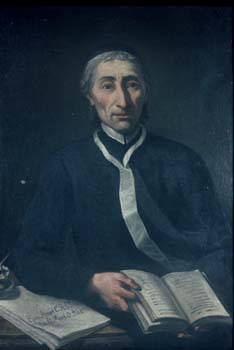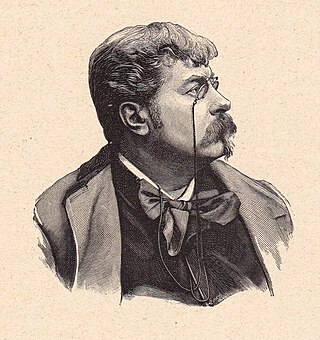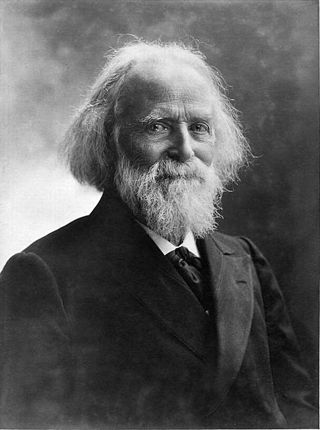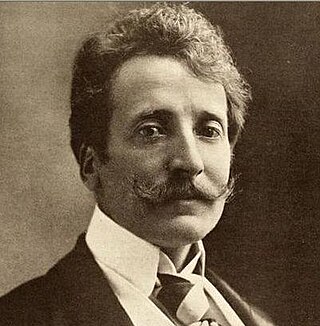This article relies largely or entirely on a single source .(February 2012) |

Octave Pirmez (1832 – May 1883) was a Belgian author born in Châtelineau.
This article relies largely or entirely on a single source .(February 2012) |

Octave Pirmez (1832 – May 1883) was a Belgian author born in Châtelineau.
Octave belonged to a well-known Belgian family. His cousin, Edouard Pirmez, was distinguished for his works on literary and political subjects. He lived an uneventful life at his family's château at Acoz, in Gerpinnes in Hainaut, where he died. [1]
Pirmez was an ardent admirer of the French Romanticists. His works include:
These books form a history of his emotional life, and reveal an extreme melancholy. [1]

Eusebius Amort was a German Roman Catholic theologian.

Octave Henri Marie Mirbeau was a French novelist, art critic, travel writer, pamphleteer, journalist and playwright, who achieved celebrity in Europe and great success among the public, whilst still appealing to the literary and artistic avant-garde with highly transgressive novels that explored violence, abuse and psychological detachment. His work has been translated into 30 languages.

Châtelet is a city and municipality of Wallonia located in the province of Hainaut, Belgium. It lies on the river Sambre.

José-Maria de Heredia was a Cuban-born French Parnassian poet. He was the fifteenth member elected for seat 4 of the Académie française in 1894.

Antoine Louis Camille Lemonnier was a Belgian writer, poet and journalist. He was a member of the Symbolist La Jeune Belgique group, but his best known works are realist. His first work was Salon de Bruxelles (1863), a collection of art criticism. His best known novel is Un Mâle (1881).

Jules Arsène Arnaud Claretie was a French literary figure and director of the Théâtre Français.

Edward Dowden was an Irish critic, professor, and poet.
Antoine de Jussieu was a French naturalist, botanist, and physician. The standard author abbreviation Ant.Juss. is used to indicate this person as the author when citing a botanical name.

Jean-François Ducis was a French dramatist and adapter of Shakespeare.

Octave Feuillet was a French novelist and dramatist. His work stands midway between the romanticists and the realists. He is renowned for his "distinguished and lucid portraiture of life", depictions of female characters, analyses of characters' psychologies and feelings, and his reserved but witty prose style. His most popular work remains his 1858 novel Le Roman d'un jeune homme pauvre, which has been adapted for film many times by Italian, French, and Argentinian directors.

José Ignacio Javier Oriol Encarnación de Espronceda y Delgado was a Romantic Spanish poet, one of the most representative authors of the 19th century. He was influenced by Eugenio de Ochoa, Federico Madrazo, Alfred Tennyson, Richard Chenevix Trench and Diego de Alvear.

Jacques Élisée Reclus was a French geographer, writer and anarchist. He produced his 19-volume masterwork, La Nouvelle Géographie universelle, la terre et les hommes, over a period of nearly 20 years (1875–1894). In 1892 he was awarded the Gold Medal of the Paris Geographical Society for this work, despite having been banished from France because of his political activism.

Henri-François-Joseph de Régnier was a French symbolist poet, considered one of the most important of France during the early 20th century.
Helgaud or Helgaldus, French historian and biographer, was a monk of the Benedictine Abbey of Fleury.

Théophile "Théo" van Rysselberghe was a Belgian neo-impressionist painter, who played a pivotal role in the European art scene at the turn of the twentieth century.

Jean Claude was a French Protestant.

Paul Jean Clays was a Belgian artist known for his marine paintings.

Georges Raymond Constantin Rodenbach was a Belgian Symbolist poet and novelist.

César Chesneau, sieur Dumarsais or Du Marsais was a French philosophe, grammarian and contributor to the Encyclopédie ou Dictionnaire raisonné des sciences, des arts et des métiers.

Acoz Castle, also known as the Château Pirmez, is a château in Acoz in the municipality of Gerpinnes, Hainaut, Wallonia, Belgium.